KPI — August 2023: State of the Economy

The Consumer Price Index for All Urban Consumers (CPI-U) increased 0.2% on a seasonally adjusted basis, according to the U.S. Bureau of Labor Statistics. Over the last 12 months, the all-items index increased 3.2% before seasonal adjustment.
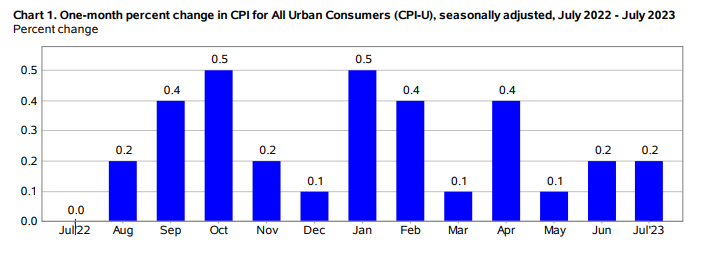
Important Takeaways, Courtesy of the U.S. Bureau of Labor Statistics:
- Categories on the rise in May include shelter, motor vehicle insurance, education and recreation. The indexes for airline fares, used cars and trucks, medical care and communication decreased month-over-month.
- The all-items index increased 3.2% year-over-year in July, slightly above the 3% increase posted a month prior. The all items less food and energy index rose 4.7% year-over-year. The energy index decreased 12.5%, while the food index increased 4.9%.
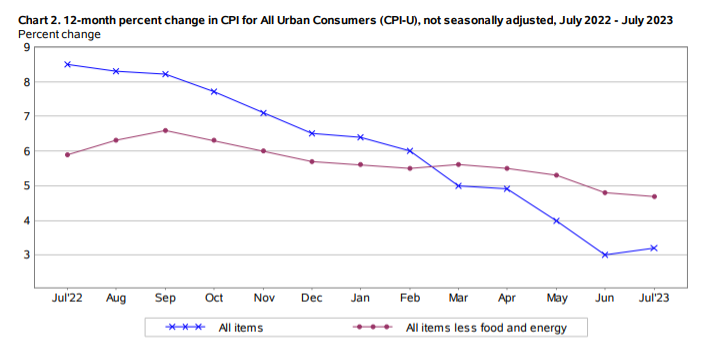
Employment
Total nonfarm payroll employment increased by 187,000 in July – below Dow Jones’ estimates of 240,000. In addition, total nonfarm payroll employment for May was revised down by 25,000, from +306,000 to +281,000, and the change for June was revised down by 24,000, from +209,000 to +185,000. With these revisions, employment in May and June combined result in 49,000 lower than previously reported.
In July, the unemployment rate and number of unemployed persons dipped to 3.5% and 5.8 million, respectively, while the average hourly earnings rose 4.4% annually, according to the U.S. Bureau of Labor Statistics. The labor force participation rate was unchanged at 62.6%, with the long-term unemployed (those jobless for 27 weeks or more) accounting for 19.9% of the total unemployed.
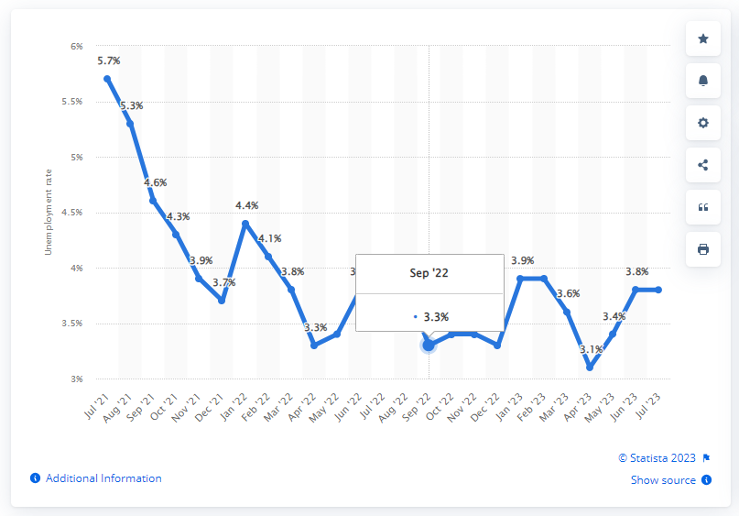
Monthly unemployment rate in the U.S. from July 2021 to July 2023 (seasonally-adjusted).
There continues to be a tug of war between the overall economy and labor market, with leading economists in professional disagreement about current economic conditions.
“The labor market’s still resilient, with more job opportunities out there than there are candidates looking for work,” says Amy Glaser, senior vice president at staffing firm Adecco. “It matches what we’re seeing, and I think it’s going to continue in this manner.”
Moreover, those who share a similar sentiment say current economic conditions also fuel the notion that the Federal Reserve can rein in inflation and achieve a “soft landing” without massive layoffs. For them, the July employment situation is positive, kicking recession predictions further down the road or erasing them altogether.
“When monthly job growth [of 187,000] strikes some as disappointing, it’s evidence of people growing accustomed to amazing economic news,” says Steve Benen, MSNBC News. “[In actuality,] it appears the job market is starting to return to a pre-pandemic normal amidst steady growth and low unemployment.”
Other industry experts imply “it is likely not enough” – that Federal Reserve rate hikes combined with further deterioration in the labor market are needed to pull inflation down to a manageable 2% target.
“We believe that unemployment probably has to get somewhere around 4.5% to get the downward pressure you need on wages to achieve that 2% target,” says Andrew Patterson, global chief economist with Vanguard’s Investment Strategy Group.
Meanwhile, the Federal Reserve’s unanimous decision to raise interest rates for the 11th time since policymakers began tightening in March 2022 puts the key benchmark federal funds rate at a current range of 5.25% to 5.5% – the highest level since 2001.
The move further restricts economic activity, as the borrowing costs for homes, cars and other items climb higher – applying even greater financial pressure on American households. Moreover, many economists agree that it likely is not the last rate hike to help suppress inflation.
For broader context, this economic data is on the heels of a U.S. manufacturing PMI in contraction and a recently downgraded credit rating by Fitch Rating. The ratings agency pointed to America’s “erosion of governance,” rising deficits and tightening by the Federal Reserve as cause for downgrade. The news is creating “a fresh wall of worry” about the economy and financial markets, with the S&P 500 in a tailspin.
Fitch expects the U.S. economy to slip into a mild recession in the fourth quarter, while other leading economists point to macro-economic data that supports a recession is already in motion.
By Demographic
This month unemployment rates among the major worker groups: adult women – 3.1%, adult men – 3.3%, teenagers – 11.3%, Asian – 2.3%, White – 3.1%, Hispanic – 4.4% and Black – 5.8%.
Last month, unemployment rates among the major worker groups: adult women – 3.1%, adult men – 3.4%, teenagers – 9.8%, Asian – 2.8%, White – 3.1%, Hispanic – 4.3% and Black – 5%.
Unemployment rates by age, sex, race, and Hispanic or Latino ethnicity
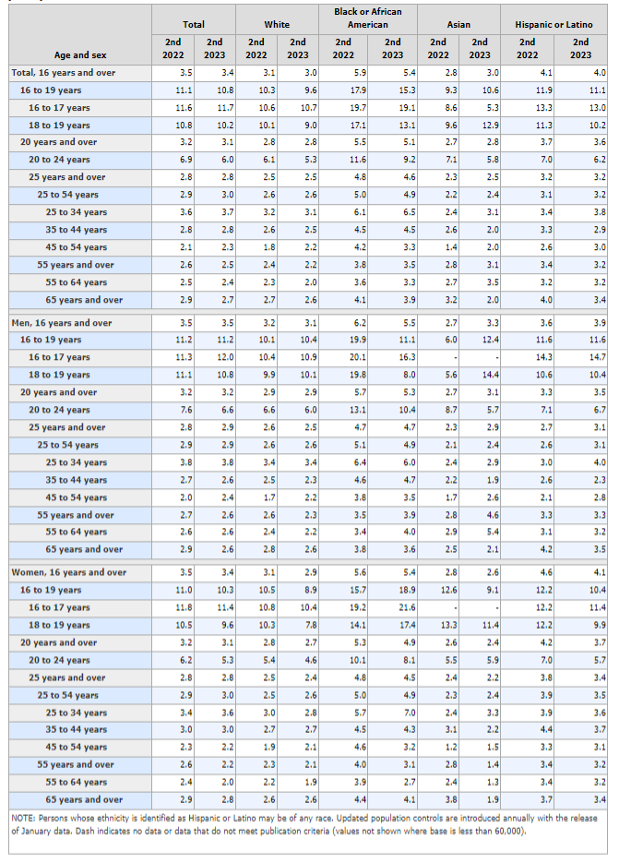
Chart provided by Bureau of Labor Statistics
By Industry
The labor market remains tight by historical standards, with job growth trending up in health care, social assistance, financial activities and wholesale trade. That said, finding workers and filling jobs is heavily influenced by factors such as skills, geography and inflation, says Giacomo Santangelo, an economist with employment website Monster and a senior lecturer of economics at Fordham University.
“[Overall,] we expect positive employment growth for the coming months even if the rate slows down. With continued strength in the labor market and elevated wage growth, we anticipate the Federal Reserve will raise interest target rates one more time,” according to Selcuk Eren, senior economist at The Conference Board.
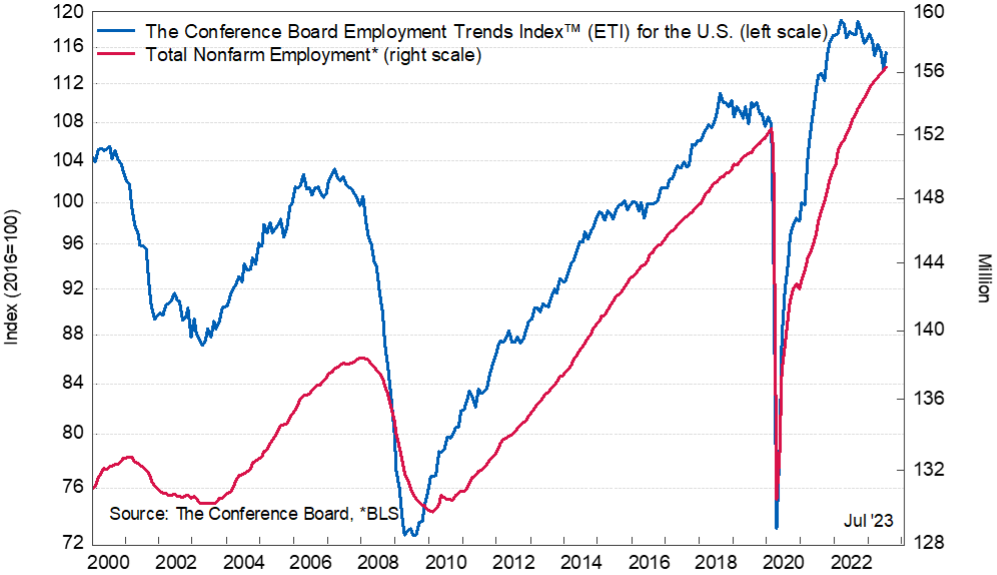
The Conference Board Employment Trends Index™ (ETI) increased in July to 115.45, up from a downwardly revised reading of 113.56 in June. The Employment Trends Index is a leading composite index for employment. When the Index increases, employment is likely to grow as well, and vice versa. Turning points in the Index indicate that a change in the trend of job gains or losses is about to occur in the coming months.
Important Takeaways, Courtesy of the U.S. Bureau of Labor Statistics:
- Health care added 63,000 jobs, compared with the average monthly gain of 51,000 during the prior 12 months. Job growth occurred in ambulatory health care services (+35,000), hospitals (+16,000) and nursing and residential care facilities (+12,000).
- Employment in financial activities increased by 19,000, adding an average of 16,000 jobs per month in the second quarter of the year. Job gains in real estate and rental and leasing (+12,000) was partially offset by a loss in commercial banking (-3,000).
- Employment in construction is up (+19,000), which is in line with the average monthly gain of 17,000 in the prior 12 months. Job growth occurred in residential specialty trade contractors (+13,000) and in nonresidential building construction (+11,000).
Click here to review more employment details.
“Looking ahead, we expect the Fed’s rate hikes will have a discernible impact on job growth, with likely job losses in early 2024,” Eren says. “As a result, we forecast the unemployment rate to start ticking higher and rise to 4.2% by the middle of 2024, corresponding to around 700,000 job losses. However, we anticipate that jobs will quickly recover, and tight labor markets will return by the end of 2024.”
KPI — August 2023: Consumer Trends
Key Performance Indicators Report — August 2023



